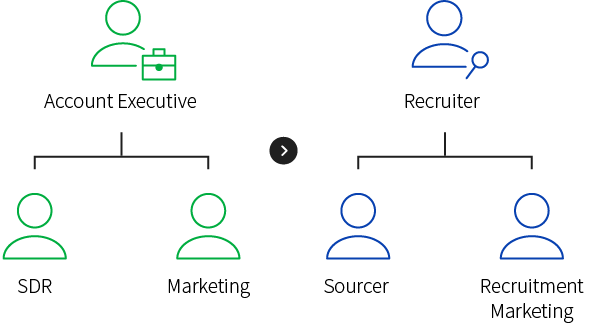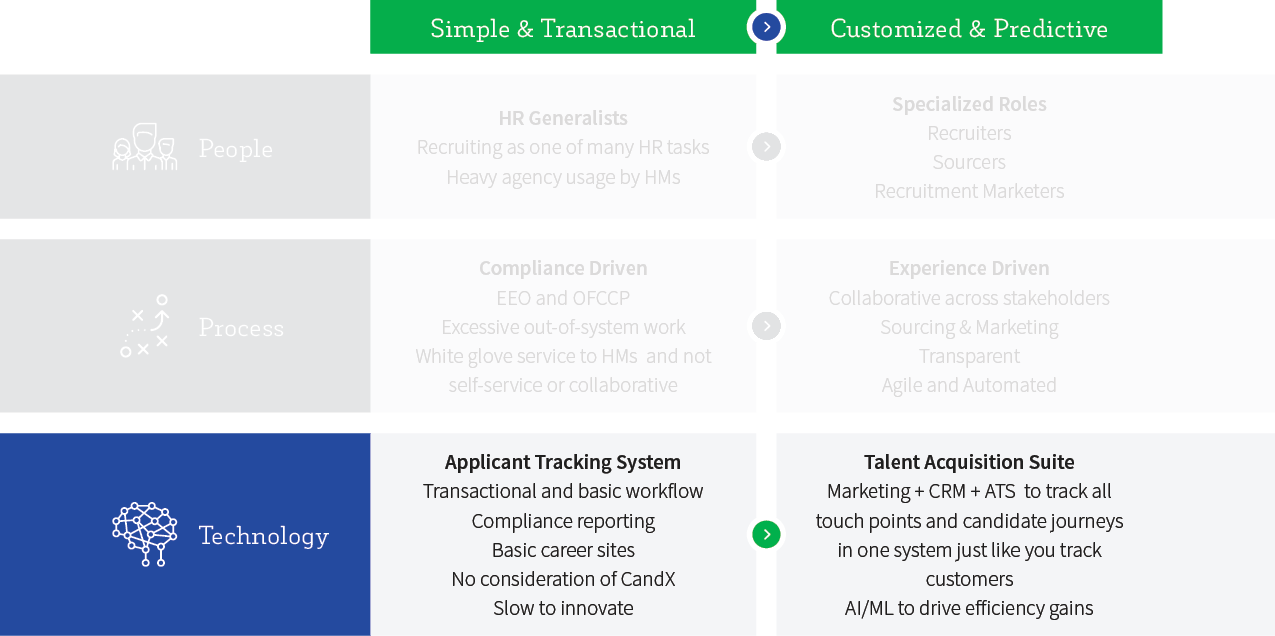Continue Reading
Laying the Foundation
Before we move full speed ahead, let’s recap. Hiring Success is defined as the ability to attract, select, and hire the best candidates, on time and on budget. It encompasses three core principles: a compelling candidate experience, engaged hiring managers, and productive recruiters. Successfully delivering on these outcomes, however, requires investment in what we call the Pillars of Hiring Success: Talent Attraction & Engagement, Selection & Collaboration, and Management & Operating Model.



Supporting the entire framework of Hiring Success are three foundational elements: people, process, and technology. Though the concept of people, process, and technology was coined back in the early 1960s, it is still fundamental to all transformational business efforts. The core idea is that people apply processes to optimize their efficiency, and leverage technology to help them automate and innovate. All three work in tandem to maximize business outcomes. This makes people, process, and technology the foundation on which all businesses need to build before venturing towards Hiring Success.
This part of the guide begins with a bird’s-eye view of the people, process, and technology required to run a successful TA function, followed by a tested framework you can use to evaluate these three elements at a more tactical level across each pillar of Hiring Success. From there, you will have a detailed understanding of what needs to be built and improved upon in order to achieve your business’ hiring objectives.
People: TA Organizational Structure and Skills


Team Structure
Recruiting is an external-facing function, where the majority of time is spent interacting with candidates. But are recruiting teams structured like other external-facing functions like sales and marketing? Let’s review the structure of the modern sales force.
In B2B sales, the golden triangle consists of an account executive, who is supported by marketing, and sales development representatives (SDR). Marketing builds brand awareness and initial interest. SDRs prospect outbound and build a pool of qualified sales leads. The account executive is in charge of nurturing the relationship and closing the deal. Today the recruiter is trying to do all three jobs in most organizations and often not successfully. The sales framework should be applied to the modern recruiting team to amplify its effectiveness and efficiency.
The golden triangle in talent acquisition consists of a recruiter, who is supported by recruitment marketing and sourcers. Recruitment marketing builds awareness of the brand and generates a strong applicant pool. The sourcer, like an SDR, widens the team’s reach and establishes initial engagement through multiple touchpoints. The recruiter then deepens the relationship and converts the top passive talent.
Other Specialized Roles
A truly modern talent acquisition organization is no longer comprised of HR generalists, but a mix of specialized roles that cover all the functions of a talent attraction strategy. In addition to recruitment marketers, sourcers, and recruiters, consider other necessary headcount investments for the following roles:
- Recruiting coordinator: ownership of interview scheduling, onboarding, travel arrangements, etc.
- Dedicated HRIT analyst for TA: ownership of key metrics and reporting, privacy and compliance, akin to a sales operations function
- Dedicated HRIT admin for TA: ownership of system performance and integrations (TA deserves its own suite!), can be distributed across a number of roles (HR ops, HR systems architect)
Skills Gap
In addition to having the above structure in place, it’s imperative that TA teams adopt skills that, until recently, weren’t viewed as essential for recruiters.
For example, it’s now more important than ever for recruiters to have a strong command of marketing-related skills. Just like consumers, candidates are becoming more savvy and selective in their “job shopping” process. This makes the process of “marketing” and “selling” jobs radically different than it used to be. Investing in recruiting in the same way that your company invests in marketing to acquire customers is going to become a table stakes need of tomorrow.
Another critical skill set that recruiters need to adopt is data analysis so that they can drive strategic decisions and improve hiring outcomes. Bersin’s 2018 study High Impact Talent Acquisition reported that successful TA teams are 6x more likely to use AI and predictive analytics and see 30% greater profitability compared to those that don’t.



- What marketing best practices could we adopt?
- How well do our recruiters know their candidates? Have they built strong relationships with them?
- Do we use any metrics to evaluate budget optimization, recruiting speed, and quality of hire? If not, what metrics should we consider?
Process: Seamless and Efficient Experiences
According to CareerBuilder, 1 in 5 candidates won’t complete an application that takes them 20 minutes or more to complete. Lengthy applications, among other things, detract from a critical component of Hiring Success—the candidate experience.
A recent Randstad Sourceright study found that 77% of organizations characterized their current candidate experience as “excellent or very good.” The majority of candidates disagree. The same study found that 84% of job seekers had a negative encounter during the recruitment process. And more than half claimed to have had more than one poor experience.
The good news? These bad experiences can be turned around. By taking a closer look at where companies commonly fall short at different stages of the hiring process (and taking a moment to reflect on your internal process and candidate experience), we can gain insight into what needs to be improved first. Throughout the next chapter we will provide many ways to build efficient processes and productive (happy) teams in order to delight candidates.

Technology: Productive Tools
When people and processes interact with technology they innovate and automate. In this sense, technology acts as a catalyst for transformation, allowing the right people and processes to execute change efficiently and effectively. Moreover, technology enables hiring teams to spend less time on manual or administrative tasks and devote more time to candidate nurturing and relationship building.

Picture this: your recruiter labors tirelessly over an impossible, multi-page spreadsheet, wiping a bead of sweat from their brow.
In between toggling through cells, they navigate to their browser, which has forty open tabs—a daunting mixture of candidate profiles within an ATS, LinkedIn pages, background screen portals, assessment tool logins, HRIS, emails, and more.
This is what happens when poor process is paired with subpar technology. It’s not effective, and it’s certainly not going to result in impactful reporting for management and other stakeholders in the hiring process. This kind of disorder can only be resolved through change.
One of the first steps is to take an honest appraisal of your current technology stack. As Maya Angelou once said, “If you don’t know where you’ve come from, you can’t know where you’re going.”
Here’s an overview of three common stages of talent acquisition tool usage among our clients—from SMBs to enterprise:
The Dark Ages: Excel Sheets, Manual Tasks, and Nobody Knows What’s Happening
Remember that tired recruiter? This is the stage in which you may find that individual.
- Recruiters have an ATS, but engagement across teams is somewhat low or inconsistent.
- Candidate experience is inconsistent: assessments are sent to some candidates and not others. Some wait two days, others two fortnights.
- Managers and leaders are in pain: reporting is at best an approximate guess due to low engagement from key users.
Nailed the Basics: The Stage is Set for a TA Revolution
Organizations in this phase have things pretty much under control, but there’s still something missing.
- ATS admins don’t love the system, but can’t find enough wrong to remove and replace without consequence to the business. Hiring managers are more engaged in this stage, but aren’t fully in the driver’s seat.
- Leaders can measure basic metrics like time-to-fill, cost-per-hire, and see how they’re doing against a quarterly/yearly hiring plan.
- With many great options on the market, the team is left wondering: Could we be doing things better?
Funky and Clunky: Legacy System with Tack-Ons, Nobody is Happy
Teams get work done, but the tools used by companies in this stage are archaic, and often little more than mechanisms to move candidates from stage to stage (as opposed to engaging with them in an authentic way).
- The tools used today seem to be a way of life within the company, but nobody seems to actually like it.
- Recruiters are annoyed and complaining about how clunky or “old school” the platform is, or how it takes 15 clicks to move from a candidate page back to an open requisition.
- You follow the company that makes your tool on LinkedIn, but you notice their competitors are growing at a faster rate and building better functionality faster than who you’re with now.
Comprehensive Suite
Truly modern recruiting platforms enable recruiters to make more effective and data-driven hiring decisions. This can only happen when the technology supports the entire hiring process.
- Does the suite help us find, engage, nurture, attract, convert candidates through branded advertising, landing pages, career pages, lead capture forms, referrals, email campaigns, etc.?
- Are the recruiting processes flexible and collaborative?
- How easy or intuitive is the technology to use?
- Does the technology improve recruiter productivity by centralizing all data, processes, and suppliers into one system?
- Can the system be configured for multiple different processes for hiring different types of positions?
- What sort of global functionality is offered for hiring teams—support for local languages, regulatory compliance, etc.?
- Does the system easily integrate with all third-party vendors (LinkedIn, Indeed, Glassdoor, Google Suite, assessments, video interviews, chatbots, reference checks, background checks, etc.) needed to support your hiring processes?
Your final choice of vendor will also depend on your unique business needs. Evaluating technology solutions is rarely a siloed decision, which is why it’s worth securing buy-in from other key stakeholders, each of whom have different priorities and concerns:
| Stakeholder | Preferences |
|---|---|
| Consistent data, an intuitive user interface, process integration | |
| Time efficiency, low costs, more empowered users, consistent performance, custom integrations | |
| Branded applications, high user engagement, flexibility for business needs and priorities |
Ultimately, the best solution is feature-rich and easily adopted, the latter of which means thinking about the experience of the end user—candidates, recruiters, sourcers, interviewers, and hiring managers.
You can learn more about the functional and technical requirements that define a true end-to-end talent acquisition Suite in Section 02 | Strategize under the Management & Operating Model.

Final Thoughts
Now that we’ve explored the challenges and solutions across people, process, and technology, where is your business positioned? Is it where you expected? The next chapter provides a framework on how you can evaluate the people, process, and technology you currently have in place and what it will take to level up the capabilities of your TA function.